 |
||
|
||
| ||
Production, technologies, equipmentJuly 2002 will be remembered in the semiconductor industry because several largest brands cut previously approved investments into the capital construction. Many, if not all, chip makers suffered losses in a rather hard 2001 and even H1 2002. Pity, but most forecasts about serious industry improvement by the summer 2002 turned false and orders haven't grown considerably. Now even the most daring analysts do not forecast the restoration of semiconductor industry in 2003, and makers are forced to submit to the recession and cut previously planned development funds. H1 2002 was too strained and uneasy. Following Intel, STMicroelectronics, TSMC, UMC, Chartered Semiconductor, etc. announced the reduction of capital construction funds. How will it be conducted? Different companies will do it their way. Intel, for example, previously planned to spend about $5.5 billion dollars for the capital construction in 2002, in July decided to cut it to $5.0-$5.2 billion. According to the company, this will mainly touch equipment purchases, not the construction. TSMC, in its turn, restrained its plans of 300 mm wafer tools launch, even despite its closest rival - UMC - announced only the economy of funds for 200 mm wafer equipment. Marketing VLSI Research has already announced that the industry will suffer a double strike: to semiconductor makers and chip production tool makers. Dataquest offered some more precise numbers: new chip production tools market will recess by another 20% in 2002 comparing to 2001, but will grow by 42% in 2003. Though, despite the above sad estimations, it's not that bad. Currently, according to Dataquest, we witness the boom of 300 mm wafer fabs launch - there are already 13 of them now, and their number will grow within these months. According to analysts, this long-awaited "300 mm revolution" is the first step to the rapid industry restoration by the middle of 2003. In the middle of July Texas Instruments announced the end of qualification tests and launch of 0.13-micron copper process technology on 300 mm DMOS 6 fab, that already began the volume production of silicon wafers. On the very last day of July IBM announced the launch of its 300 mm East Fishkill, New York fab. The second after D1C in Hillsborough, Oregon, closest to the volume production of 300 mm wafers Intel's Fab 11X in Rio Rancho will be launched in October. Micron reported that its pilot 300 mm wafer production line will be launched this year, however the company still follows a waiting strategy basing on the rationality and "lowest bit cost". In July Samsung Electronics began constructing its second 300 mm Fab 12, having selected the required production tools. In April-May 2003 Samsung plans to launch volume production of 300 mm wafer chips. Fab 11, producing both 200 mm, and 300 mm wafers chips, is now only half-used. The second queue will be fully used for 300 mm wafer production using 0.13-micron process technology. As for the unsuccessful H1 2002, I should note this didn't happen everywhere. If I can relatively assuredly state the reduction of GPU and mobo chipsets sales, then other segments, like chips for WLAN, mobile and wireless phones, Ethernet switches, network interfaces and ADSL equipment experienced the considerable growth. The same can be said about some consumer electronics segments - DVD and VCD player chips, digital cameras, TV and game console chips. So, in general, PC component market is still the slowest to restore. Sceptical Gartner Dataquest has already reduced the forecast for PC component market yearly growth in 2002 to 2-4% from the previous 5%. As for PC progress in general, I'd like to note the adoption of official PCI-X 2.0 specs and preliminary PCI-X 2.0 electrical part by PCI-SIG Board of Directors. Both parts give developers the complete info for releasing new PCI-X 266 and PCI-X 533 products. PCI-X 2.0 specs define two new PCI-X card versions: PCI-X 266 and PCI-X 533. The former feature 266 MHz clock rate and provide over 2.1 GB/sec throughput. PCI-X 533 operate at up to 533 MHz and provide over 4.2 GB/sec throughput. This is more than enough for 10 Gigabit Ethernet, 10 Gigabit Fibre Channel, Serial Attached SCSI, Serial ATA (SATA), InfiniBand, RAID and cluster connections. The new standard is backward compatible with previous PCI versions, enabling system and mobo developers accelerate PCI-X 2.0 product deployment. In addition, another important event. Last month we got to know that one of the Intel Developer Forum (IDF) sessions will take place in Moscow, Russia. Russia will become the first EMAR country to host such a session. The main theme of the Moscow IDF will be the adaptation and deployment of modern computer and communication technologies, the construction of technological ecosystems on Intel architecture, including both hardware, and software solutions. Processors
The main processor event of July is the official Intel announcement of commercial shipments of second-generation 64-bit Intel Itanium 2, previously codenamed McKinley. The mass adoption of Itanium 2 by the industry, naturally, speaks for the platform maturity. Besides, current Itanium 2 solutions will be hardware compatible with two future-generation Itanium processors. The scrupulous design of new-generation system's hardware is now coupled with the new-level software part: Itanium 2 architecture is supported by Microsoft Windows, Hewlett-Packard HP-UX, Caldera Linux, MSC.Software, Red Hat, SuSE and TurboLinux. Besides, , Microsoft plans to release Windows.NET Datacenter and Enterprise Server for Intel Itanium 2, and HP plans to present its OpenVMS and Non Stop Kernel versions, optimized for all processors of this family. 
Intel Itanium 2 CPUs feature 3MB or 1.5MB of L3 cache, 900 MHz and 1.0 GHz clock rates for $1338-4226. It's interesting that Intel offers system builders a structure component SR870BN4 platform based on Intel Itanium 2 and Intel 82870 chipset along with processors themselves. This platform will appear already this half-year and will support up to 4 CPUs. 
Itanium 2 processors were released a little before the announcement of aforesaid Intel E8870, officially expected in fall 2002. The chipset supports 2 to 16 processors in one system. Perhaps, Dell hasn't announced its corresponding products along with other companies in the beginning of July. Well, the decision to wait for the release of the base chipset for the new platform is wise, though even some OEM makers like NEC, HP, etc. announced their Itanium 2 chipsets. It's indicative that there are not only multi-processor servers, but also workstations among these solutions. Hewlett-Packard presented single-CPU HP Workstation zx2000 and dual-CPU HP Workstation zx6000 on the proprietary zx1 chipset. 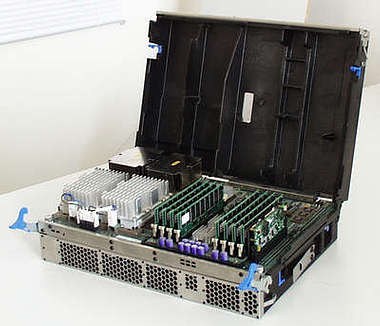
The support of Itanium 2 was announced by many leading component makers: NVIDIA, ATI, LSI Logic, QLogic, etc. The ready products will be shipped by Bull, NEC, HP, Russian Kraftway (Kraftway GEG Express 6402), Hitachi. It seems that second-generation 64-bit Intel processors came here for a long time. In July SGI presented its plans for development of its own MIPS-based processors up to 2006. As well as all industry leaders, SGI isn't going to be left aside the releases of 64-bit Intel-based servers: its SGI Origin Itanium 2 systems will operate under Linux. Nevertheless, the company still holds on to its own CPU line as well. The new SGI MIPS-based systems will work under IRIX - UNIX-based SGI OS. In the next year these systems will be made on the new MIPS N series. But, as these CPUs will have just slightly changed architecture, their performance is expected to slightly exceed current R14000. 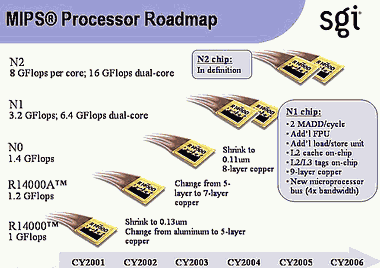
SGI plans a serious breakthrough in 2005, when system performance grows from 1.4 Gflops per core (N0 chips) up to 8 Gflops per core. In 2003 SGI plans to release the so-called "super bricks" similar to high-performance blade servers. In 2004 SGI plans to add the so-called "teraracks" - modules made of blade systems. In 2006 we'll see the next, even more integrated SGI systems - "teracubes". According to SGI, teraracks are "1 terainstruction/sec per rack". Supposedly, each CPU in such rack will dissipate about 15-20 W power. Theoretically, new SGI servers, planned to 2005, will be able to feature 32768 processors. The next generation of N1 / 4.2 Gflops processors will have on-chip L2 and L3 caches. According to the roadmap, the company also plans to release a chip with two N1 cores and 6.4 Gflops total performance. N2 processor, being already developed, will feature up to 8 Gflops per core performance or 16 Gflops in dual-core configuration. Besides numerous official messages from Intel about stepping changes and cancellation of obsolete 0.18-micron processors, company partners reported that Intel changed its new CPU roadmap. So, the release of 2.8 GHz Pentium 4, previously planned to 4Q, is now expected in the current 3Q. Besides, they'll also present 2.5 GHz, 2.6 GHz and 2.66 GHz models. 1.9 GHz Socket 478 Celeron, made using 0.13-micron technical process are expected in September, according to some preliminary data. 2.80 GHz of server Xeon will also be announced this quarter, having been previously planned closer to the year-end. In general, we receive reports that the company is pleased with 0.13-micron technology mastering and plans to release about 33 million processors in 3Q 2002. At that Pentium 4 533 MHz FSB chips will make 46%, Pentium 4 400 MHz FSB chips - 24%, Socket 478 Celeron - 16% and Socket 370 Pentium III - 14%. By the way, according to the preliminary data, Pentium III-S with 512KB cache will be cancelled closer to the end of 2002. In July AMD officially presented its new Mobile Athlon XP 1800+ with 1.53 MHz actual clock rate, being 66 MHz higher than its 1.47 MHz Mobile Athlon XP 1700+ successor. The new chip has Thoroughbred core and is made using 0.13-micron process technology. Mobile Athlon XP 1800+ notebooks were announced by Hewlett-Packard (HP Pavilion ZE1250 and Compaq Presario 900), Sony (Vaio FXA) and ACER Europe (Acer Aspire 1300). But the details about AMD Hammer processors, being prepared for release, are more interesting. In July the company has at last specified chips' cache capacity: 64-bit Athlon ( former ClawHammer) will be made with 256/512KB L2 cache, Opteron - 1 or 2MB L2 cache. The core of new Athlon will be 104 sq.mm in size. At the same time AMD confirmed that the current generation of Hammer processors feature integrated memory controller supporting only DDR-I, and that DDR-II support will require chip redesign, at least its memory controller. Though, according to the company, it's not that complex. AMD shows stable assuredness that DDR-II won't appear in volume on the market before 2004. By that time AMD plans to release newer version of Hammer core with DDR-II support. Because of the launch of Texas Instruments' DMOS 6 fab for 300 mm wafer chip production, we started to see the news about Sun Microsystems' UltraSparc family, made by TI. As you know, Sun top-end chips with 1.05 GHz clock rate have been produced only on 200 mm wafers and used only in special workstation line. The release of UltraSparc processors on 300 mm wafers with about 0.12-micron elements (instead of 0.15-micron elements of current 900 MHz Sun chips) will enable to increase production volumes due to higher yield. According to TI and Sun, in the near future both companies plan to launch the volume production of 1.2 GHz UltraSparc III processors. In the beginning of 2003 TI plans to master the pilot production of 0.09-micron processor prototypes to launch their volume production in the end of 2003 - beginning of 2004. The new-generation Sun UltraSparc IV processors will be made using 0.12-micron process technology, the next generation - UltraSparc V - already using 0.09-micron process technology. By the way, Fujitsu Technology, that ships Unix servers under Sun Solaris on proprietary Sparc64-GP processors, in July announced that its chips, that previously featured up to 675 MHz clock rate, have at last passed the 700 MHz limit and now operate at 810 MHz, 788 MHz and 700 MHz. Some words about Transmeta. Pity, but in July it decided to dismiss 40% of staff, i.e. 200 people, and delete integrated Crusoe TM6000 from its roadmap. Now the company will focus on the marketing of rather successful TM5800. Following the strict economy, the company plans to become profitable within a year. It seems that Transmeta is aimed only at the survival. System boards and chipsetsJuly this year brought us lots of new chipsets. New boards are expected in August-September, when the buyers are most active. NVIDIA presented its next-generation integrated chipsets for Athlon XP / Duron - nForce2 or former Crush17/18. 
nForce2 supports DDR SDRAM, including still non-standard DDR400, MCP (Media Communication Processor) Southbridge features IEEE 1394, USB 2.0 and surprisingly two Ethernet (LAN / WAN) controllers. Currently nForce2 family contains two Northbridges: discrete nForce2-ST and nForce2-GT with integrated GeForce4 MX core. IGP (Integrated Graphics Processor) of the new nForce-GT considerably differs from its nForce's GeForce2 predecessor by performance. Integrated GeForce4 MX graphics operates at 250 MHz, supports DirectX 8. Motherboards on new chipset feature AGP 8x slot, that can be used not only for an add-in graphics card, but also for DVI/TV Riser Card, promoted by NVIDIA, providing DVI and TV outputs. Southbridge or MCP (Media Communication Processor) will also have two variants: complete MCP-T (IEEE 1394, USB 2.0, MAC NVIDIA, 3Com) and budget MCP (USB 2.0 and AC'97). So, we have four variants of nForce 2 North- and Southbridges total. 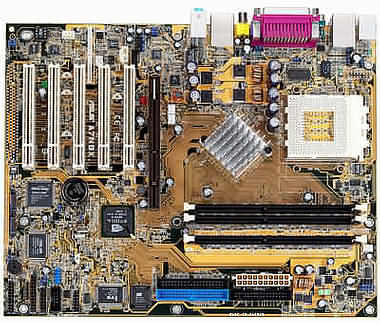
nForce2 mobos were announced by ASUSTeK (A7N8X, nForce2-ST, above), Leadtek (WinFast nForce2 K7NCR18D, K7NCR18G and K7NCR18M), ABIT (NV7II-8x, nForce2-ST, RAID), EPoX (EP-8RDA+, nForce2-ST and EP-8RGA+, nForce2-GT), Chaintech (Apogee 7NJS, nForce-GT, and 7NIF1 - Micro ATX, nForce2-GT), MSI (K7N2, nForce2-GT), and Shuttle Computer not only showed its nForce2 board, but also presented a ready barebone system. Except aforementioned nForce2 boards will be released by ABS, Alienware, AOpen, Atlas Micro, HyperSonic, Soltek, Totally Awesome and Vicious PC. nForce2 volume production is expected closer to the end of August, and the first nForce2 mobos will appear for sale in September. Another novelty from NVIDIA - Crush K8 chipset for AMD Hammer processors, is ready for volume production, and shipments are planned to 4Q 2002. Crush K8 is a discrete chipset without integrated graphics. It's interesting as it will become the first Hammer chipset, designed in a single package and combining North- and Southbridges or System Platform Processor (SPP) and Media & Communications Processor (MCP), respectively. 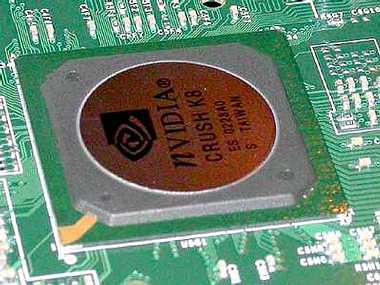
Of course, Crush K8 mobo makers will thoroughly check their semiconductor designs. According to NVIDIA, Crush K8 features 18 million transistors and will be produced using 0.15-micron process technology. Further, NVIDIA plans to release various modifications, including mobile.
In July M1687 (Northbridge) + M1563 (Southbridge) chipset bundle was officially presented by ALi Corporation for AMD Opteron and AMD Athlon-64 processors. 
ALi M1687 supports AGP 8x, HyperTransport interconnect. ALi M1563 Southbridge is a highly-integrated solution, supporting AC-Link, ATA-133, 6 USB 2.0 ports, 10/100 Fast Ethernet, Sony MemoryStick / SD, etc.
An important event of July was the release of SiSR658 RDRAM chipset by SiS. As you know, SiSR658 could appear after SiS signed a license agreement with Rambus last November. SiS evaluates the release of SiSR658 as strengthening its positions on the high-performance systems market. 
Coupled with SiS963 Southbridge, SiSR658 supports Pentium 4 with 533/400 MHz FSB and up to 3 GHz clock rates, up to 4GB of Dual RDRAM memory operating at up to 1066 MHz, AGP 8x, 5.1-channel AC'97 2.2 audio, 10/100-Mbps Ethernet, Home PNA 2.0, Dual ATA133/100/66 IDE, up to 6 PCI slots, up to 6 USB 2.0/1.1 ports. Still nobody has presented boards on the new chipset. So, we might see who will be the first already in August. Recently, still more chipset makers announced DDR400 support, but this memory hasn't yet been adopted by JEDEC. DDR400 support is featured in NVIDIA nForce2, SiS648, VIA KT400 and P4X400 other chipsets. On the other hand, Samsung is ready to produce this memory, and Winbond Electronics joined it in July. What should one do when the market is ready for a new standard, but there's no standard? Simple: try and negotiate without third parties, directly. In July we got to know that North American Samsung Electronics office signed contracts with NVIDIA, SiS and VIA Technologies, assuring chipset maker in guaranteed DDR400 production by Samsung. Now, when they are ensured of mutual support, DDR400 adoption by JEDEC becomes formal. DDR400 memory and boards are bound to appear. In the end of July one could notice DDR SDRAM PC3200 module from Samsung in retail, and the list of mobos on the aforementioned chipsets has been getting longer and longer, announcements following each other. The wave of these boards is expected in the end of August - September. There were messages about new Intel chipsets in July. Taiwanese mobo makers decided to move the release dates of 845GE and 845PE supporting DDR333 from September to October. At the same time we got information that by September Intel plans to release 845GV chipset, being a changed 845GL with 533 MHz FSB support and costing $2-$3 more. There's an opinion that Intel is to release 845GV to compete with budget solutions from SiS: SiS650 (for examples see our MSI MS6533 on SiS 650 article) and SiS651, well adopted by the market due to 533 MHz FSB, add-in graphics support, and price, being $5 less than 845GL. MemoryDuring the month memory market was a spoiler for the mood of both memory vendors, and buyers. For just several weeks we have been witnessing abrupt price growth in the middle of the month and reduction closer to the end of July. Recently the memory market has been resembling some mad exchange where growths and reductions have one-time interest only. Sometimes, on the background of rather calm and consequent price trends for other PC components, it seems that if there wasn't this memory mess, they'd have to invent another reason to speculate :-). So, let's leave this aside for news and weekly reviews and talk about July novelties. DDR SDRAM, having recently been pushing its SDRAM predecessor from the market, also leaves no chances for a serious restoration of RDRAM. Meanwhile, Rambus isn't going to give up and announces its optimism about the future of its developments. At Rambus Developer Forum Japan 2002 in the beginning of July it presented its updated roadmap, with more specified plans for the proprietary Yellowstone or Yellowstone Octal Data Rate (ODR). 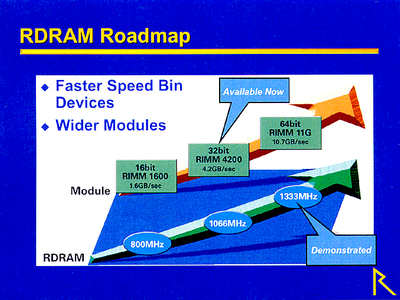
Yellowstone bases on the actually differential (unlike the previous pseudo-differential RSL) DRSL (Differential Rambus Signaling Levels), with 200 mW amplitude (1.2 V - logical 0, 0 V - logical 1), including in-crystal termination and bidirectional signalling. 
Besides, the conference also brought the announcement of a new version of RaSer V serial interface with up to 6.4 Gbps throughput. Few, by powerful enough Rambus partners - Samsung and Elpida - have also presented its RDRAM roadmaps for these years. So, Samsung already has working samples of 576 MBit chips, operating at 1.57 GHz made using 0.12-micron technology. the company plans to launch the volume production of PC1200 RDRAM in 2003, PC1333 RDRAM - in H2 2004. Except for preparations for 32-bit RIMM volume production, the company works on 64-bit modules. PC1200/1333 RDRAM RIMM modules are expected to be made with 64-bit bus. Elpida also plans to release PC1333 RDRAM in 2004. At the conference they've exactly specified RDRAM development prospects: pity, but this memory will mainly be used in high-performance servers, workstations. Most RDRAM products will work in other high-speed communication products, digital HDTV TVs and other specialized applications. If it's that good, so be it. Let's remember about something more urgent - July DDR SDRAM products. July brought announcements of DDR-II SDRAM, that is still far for masses. Japanese Elpida announced shipments of 512 Mbit DDR II SDRAM chips. 
They are made using 0.13-micron CMOS process technology in FBGA packages. Chips require 1.8 V and provide 533 Mbps throughput. Volume shipments of new EDE5104G (32m x 4bit x 4 bank), EDE5108G (16m x 8bit x 4 bank) and EDE5116G (8m x 16bit x 4 bank) are planned to 1Q 2003. In July Micron for the first time showed working samples of its DDR-II chips, though only 256 Mbit ones. According to Micron, its DDR-II chip consignments will appear by the time of appearance of the first mobos supporting this memory, i.e. by the end of 2002. They believe DDR-II will become spread on the market only in H2 2003 - beginning of 2004. Infineon presented engineering samples of 1GB Registered DDR333 SDRAM memory modules, featuring thirty six 256 Mbit chips in FBGA (Fine-Pitch Ball Grid Array) packages. 
New low-profile 184-pin (1.2-inch high for 1U servers) 1GB Registered DDR333 modules are organized into two banks, 128 Mbit x 72 each, and require 2.5 V. Their signal level is 1.25 V. Elpida had a big idea about even higher capacity and announced the shipments of 2Gb PC2100 DDR SDRAM engineering samples, aiming to launch their volume production in October. 
Modules feature low-profile 1.2-inch 184-pin package, that's very attractive for 1U servers, CAS Latency 2 / 2.5, and will be produced using 0.13-micron process technology, organized as 512 Mbit DDR SDRAM (36 per module). Unlike the traditional TSOP, enabling 36 per 6.4-6.8-thick module, the new ones utilize new TCP (Tape Carrier Package). This enables to reduce module thickness to 4.8 mm including heat-sink plates. 2GB registered ECC EBD21RD4ABNA modules are already available, organized as 256M x 72 bits, 2 banks, requiring 2.5 +- 0.2 V supply voltage. Two companies presented themselves on the high-performance graphics card memory market. In the beginning of July Infineon announced 128 Mbit DDR Graphics RAM (DDR SGRAM) operating at 450 MHz (900 MHz DDR) with 1.8 V interface. 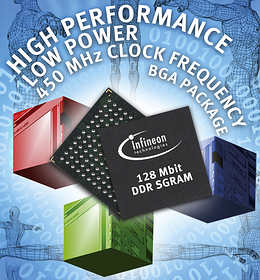
128 Mbit Infineon Graphics RAM chips are organized as 4Mx32 and can be used in 32-, 64-, 128- and 256-bit memory interface solutions. They are packaged into 144-pin FBGA, sized 11x11 mm. Their volume production is planned to 4Q 2002. Closer to the middle of the month Samsung accepted this challenge, having announced samples of 128 Mbit 1 GHz (!) memory, though meeting already DDR II specs. New 128 Mbit DDR II chips for graphics cards feature 1.8 V I/O interface, FBGA. They'll begin to spread on the market already in the current 3Q 2002. Several important events happened on the flash memory market. So, MemoryStick Duo, having been announced a couple of months ago, started to appear as real solutions. 
First, we'll see 16MB MemoryStick Duo or MSA-M16A in retail. As the new format is mainly designed for various mobile devices like cellulars, players, it has smaller size than usual MemoryStick cards (by about 1/3). The first novelties will be supplied with a special adapter. According to the company roadmap, MemoryStick Duo capacity will grow up to 128MB during the year. 16MB MSA-M16A cards will cost about $22. In July Olympus and Fuji Photo Film debuted with a new XD Picture Card flash flash standard (xD - "eXtreme digital"), that has already been named "SmartMedia killer". 
XD Picture Cards will have 128, 256, 512 MB and 1 GB capacities, and 4 GB, 8 GB are also planned to the future. Currently new cards are produced only by Toshiba (SmartMedia brands owner, by the way) and will appear for sale in volumes already this fall, first with Olympus and Fujifilm digital cameras. xD-Picture cards are sized similar to SmartMedia, but are smaller and lighter their volume is about 0.85 cubic cm, size - 20.0x25.0x1.7 mm, weight - 2 g. The new cards, supplied with a special adapter, will be compatible with many current digital cameras. Pricing will be similar to the current SmartMedia prices. VideoATI was the undoubtful hero of the month, having presented three new GPUs in the middle of July: hi-end Radeon 9700 and mainstream Radeon 9000 Pro and Radeon 9000. Let's remember the specs of high-end Radeon 9700 (codename R300):
Volume shipments of Radeon 9700 are expected after the next month, and the cards were announced only by C.P.Technology, Gigabyte, Hercules. 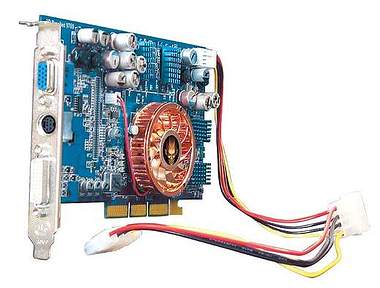
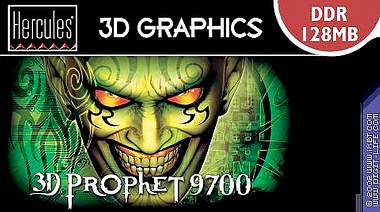
I guess the main news, reviews, etc. of this GPU are still ahead. And now you can get yourself acquainted with theoretical examination of Radeon 9700 in our ATI RADEON 9700: Analysis. 
But what a rapid fountain of Radeon 9000 / 9000 Pro releases we saw! It's hard to name a partner of ATi, who hasn't announced a card or a line on this GPU. In brief: 3D Prophet 9000 (see our RADEON 9000/9000 Pro 128MB on Hercules card review) and 3D Prophet 9700 from Hercules, AF64DG-H (Radeon 9000 PRO, the photo below, RADEON 9000 Pro 64MB) from Gigabyte, 6 Radeon 9000 Atlantis and Radeon 9000 Atlantis Pro cards from Sapphire, 3DBlaster 5 RX9000 Pro from Creative, Excalibur Radeon 9000 PRO from Hightech Information System, Radeon 9000 from Club 3D, Tachyon G9000 PRO from Tyan, Radeon 9000 Pro from CP Technology... I doubt this list is full. 

Trying to pass NVIDIA NV30, ATI has succeeded to present the complete lines based on the new GPU - from Radeon 9000 (below) / 9700 for Apple Mac to new professional FIRE GL X1, based on Radeon 9700. 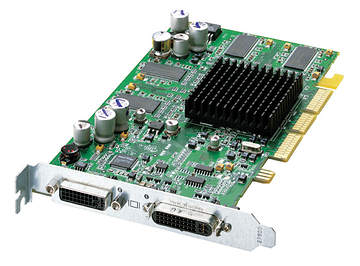

Mac cards are similar to their PC variants, with specific package lists. Professional FIRE GL X1, expected in October, will have up to 256MB of 256-bit DDR memory, will support AGP 8x, SMARTSHADER 2.0. Of course, FIRE GL X1 cards will be shipped with special professional application drivers. As there were no more special novelties in July, I'll mention some society news. There were two important events in July, regarding former German ELSA AG. The first is about the future of the bankrupt firm. From August 1 ELSA AG returned to the PC market, named ELSA GmbH, with new investors from Bremen and new policy. The new company will make SOHO solutions, including graphics and multimedia products. The assortment will narrow due to the sale of company's networking and DSL department. ELSA Japan assets, former ELSA AG subsidiary, were passed to Japanese Technology Joint Corporation (TJC), that had owned 5% of this venture before. The second event only partially touches the German company. We got to know that exclusive rights for making and selling NVIDIA Quadro4 professional workstations graphics in Asian-Pacific, previously owned by ELSA AG, were passed to Taiwanese Leadtek. And before, European and USA exclusive had been passed to North American PNY Technologies. MonitorsJuly TFT LCD market situation can be said as turning-point, as TFT LCD shipments reduced by about 5% comparing to May after the reduction of PC sales volumes. There was an interesting situation when, according to analysts, prices should have gone down, but its not the DRAM market with large amplitudes of its spot market. Monthly price changes do not exceed several per cent on the TFT LCD market, where contracts are most important. So, it would be good to support sales by price reduction, but who wants to lose revenues, as each company of this sector dreams how to launch a 5G fab. And this requires large sums of money. Many analysts forecast the restoration of market activity already in August. Though, this might not result in the increase of TFT LCD prices, because the supply grows faster than demand. Besides, the successful launch of 5G fabs by LG-Philips and Samsung Electronics might force Korean companies to cut prices to occupy most of the market. So, Taiwan will have to follow them and cut its prices as well. Another factor is that Hewlett-Packard and Dell plan to launch large TFT LCD PC sales campaigns in 4Q. These packages might make up to 30% of all PCs from these companies (against 15% last year). Perhaps, this powerful factor will press 15-inch TFT LCD prices to $240 and below in 4Q (currently $255-265) even without any efforts from LG-Philips and Samsung. Besides, TFT LCD prices are also affected by the reduction of component prices - polarizers, light filters, electronics. As for technological breakthroughs, I'll mention the announcement of Samsung about planned 6G fab for 1370x1670 mm glass substrate production. One such substrate will yield six 30-inch and sixteen 19-inch TFT LCD panels. Current 5G fabs utilize 1100x1250 mm substrates, yielding to three 30-inch and nine 19-inch panels. If the performance growth isn't tied to additional problems, then rivals will go poor, as TFT LCD prices might drop to $10 per inch for 15-inch panels. As for the interesting month novelties, I'll mention Sharp's 15-inch LL-T1502T ($1400) monitor with a sensor screen, similar to PDAs or tablets. 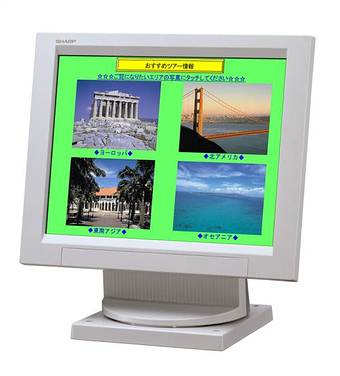
In order to provide sensor capabilities LL-T1502T (supporting 1024x768 (XGA), 170 degrees horizontal and vertical viewing angle, 350:1 contrast, 25 ms response time and 190 candles/sq.m maximum brightness) features special cover with 89% transparency and about 5-million touch MTBF. Another impressive novelty - 20-inch Brilliance 200P3M (2799 euro) from Philips, designed for finance and banking, medicine, software development, CAD/CAM applications. 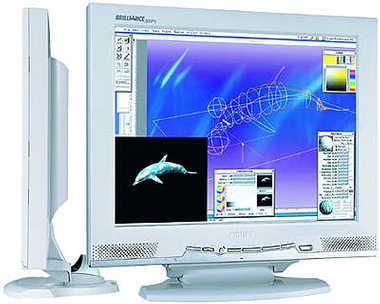
The monitor supports 1600x1200 (UXGA) resolution, up to 250 candles/sq.m maximum brightness, 300:1 contrast, 160 degrees horizontal and vertical viewing angle. The model has analog, S-Video and DVI-I inputs, supports PIP. Integrated stereo acoustics features 48 W total power (PMPO). NotebooksThis month brought many exotic notebooks. Along with usual designer tricks like fashion colors, case shapes, various interfaces, there were some odd portables. Just look at this Flip Pad Voyager from Xentex. The configuration is rather usual: AMD Athlon, 1.1-1.4 GHz, ALi (1647+ 1535) chipset, 2x144 SODIMM SDRAM, VGA - SMI 721 (8MB), 30GB hard disk. But the LCD screen features two parts - 2 x 13.3-inch. This is a "folded" Flip Pad Voyager: 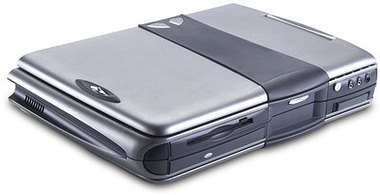
And this what it looks like unfolded: 
Another exotic notebook is the serial FLORA 270W ($2700) from Hitachi with water cooling system. The model has 1.8 GHz Mobile Pentium 4-M (Intel 845MP chipset), 128MB RAM (up to 512MB), 20GB hard disk, 16MB ATI MOBILITY RADEON 7500 graphics, 15-inch 1400x1050 (SXGA+) screen. 

The main theme, promoted by Hitachi at the announcement of FLORA 270W, was the low noise of 30 dB at operation. Will such water cooling spread in masses or not, only the time may tell. Now from exotic models let's proceed to pleasant functional models. For example, VAIO BioNote PCG-GRX91G/P ($3600) from Sony is nothing more than the first Sony notebook with a DVD-RW drive. 
The model bases on 2 GHz Mobile Pentium 4-M (Intel 845MP chipset) and has 60GB hard disk, 16-inch 1600x1200 (UXGA) display, 512MB of DDR266 RAM, 32MB MOBILITY RADEON 7500 graphics. Integrated DVD-RW slim drive can write DVD-R/RWs at the nominal speed. Drive's CD-RW/DVD speeds are 16/10/24/8x. In case anyone needs a notebook supporting high image resolution, usual to stationary workstations. In July NEC announced the release of VersaPro VA20S/AE ($3600) with 15-inch screen, supporting impressive 2048x1536 (QXGA) resolution. 
VA20S/AE is a professional CAD, DTP, etc. graphics workstation. It bases on 2.0 GHz Mobile Pentium 4-M. The standard configuration includes 128MB RAM, 20GB hard disk, 64MB MOBILITY RADEON 7500 graphics. As for the "semi-portable" desktop CPU-based novelties, I'll mention two new SmartStep models from Dell - SmartStep 200N ($1500) and SmartStep 250N ($1900). 
Both models feature Pentium 4, 15-inch screens and DVD drives, 256MB RAM and 32MB ATI graphics. They differ only by CPU clock rates (2.2 GHz of 250N and 2 GHz of 200N), by DVD/CD-RW of 250N (DVD-ROM of 200N), and 40GB and 30GB hard disks, respectively. Finally, I'd like to end the July hardware digest with an attractive DynaBook P5/S24PME from Toshiba. To provide additional comfort, the company equipped the model with a wireless detachable keyboard. 
DynaBook P5/S24PME ($2800) bases on 2.4 GHz desktop Pentium 4, has 256MB of PC2100 DDR SDRAM, 16-inch 1280x1024 LCD screen (Fine SuperView, low response time), 32MB DDR NVIDIA GeForce4 440 Go, 40GB Ultra ATA/100 hard disk, CD-RW/DVD-ROM combo supporting 16/10/24/8x speeds. The idea is unusual because it enables you to take a wireless keyboard from its socket and control the PC remotely, as 16-inch screen let's you do this as well.
Vladimir Romanchenko (lone@ixbt.com) Write a comment below. No registration needed!
|
Platform · Video · Multimedia · Mobile · Other || About us & Privacy policy · Twitter · Facebook Copyright © Byrds Research & Publishing, Ltd., 1997–2011. All rights reserved. |